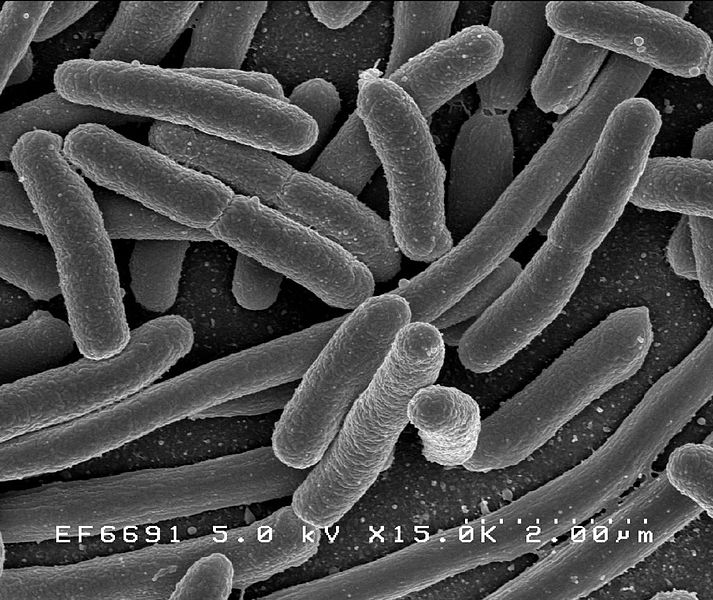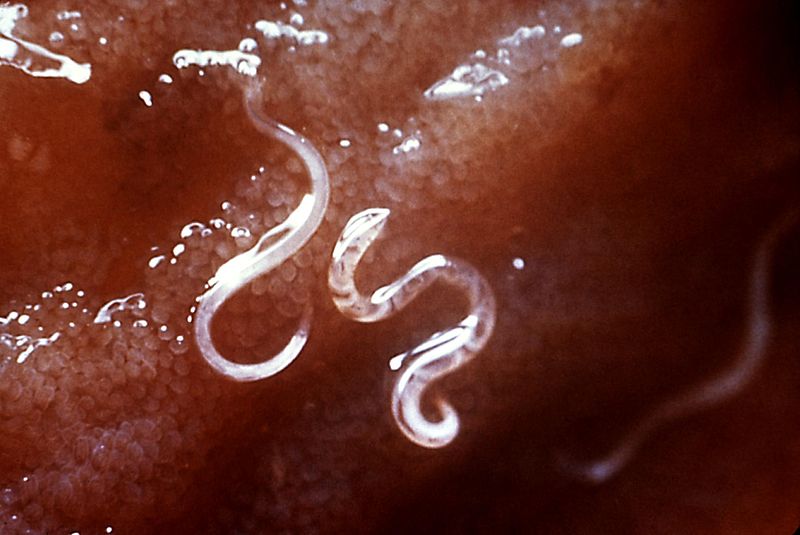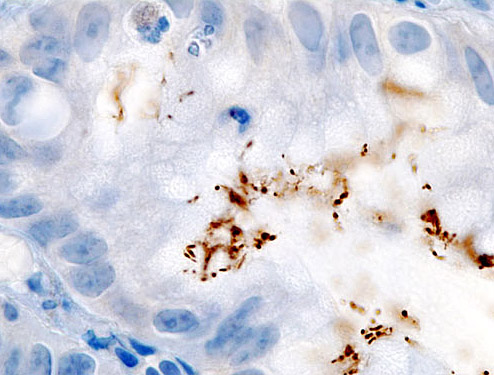COLONY MAN
by Mol. Nov. 2013

from http://en.wikipedia.org/wiki/Image:EscherichiaColi_NIAID.jpg
Image is in the Public Domain.
We like to think of ourselves as individuals, unique people, self contained - bags of salt water like gigantic cells with many processes keeping the whole thing (each of us) working. Each of us moving around in a macro world exploiting its resources of food and energy to power ourselves.
But nothing could be more wrong.
Throughout our long evolutionary history, our original forms have been invaded, reshaped, partially colonised and has interacted with other living forms, more microscopic forms than macro ones. What we are today is the product of successful adoption and collaboration of those life forms which benefited us, and we therefore accept as benevolent, or - they are there inside us and our biological systems have yielded to their tenacity to co-habit and has accepting them, even when there are negative
issues for us.
It's probable that the flora, which lives unseen along our intestinal tract, contains many living species or sub-species never properly investigated. It's even more probable that some of the allergies which seem to increase in the number of sufferers each decade are the result of eradicating internalised life forms we have lived with for years and kept subdued through our immune systems such that when those 'invaders' are gone, our immune systems remain too high in activity and manifest health issues or discomfort
simply because it (the immune system) has not realised the threat has gone.
I am no doctor, and these things are complex, and sudden in the short term when one considers the long time we have walked the earth with a constant set of previously slowly-changing circumstances, a set of conditions which have been radically altered in just under 150 years (2 generations). The human body is colonized immediately after an expectant women's water breaks and the baby leaves the sterile environment afforded by the amniotic sac. Once the baby appears in the physical world, human touching
begins the bacterial colonisation of the exterior - the skin.
It has been estimated that the human body either externally or internally carries more cells of invaders and dwellers than of the human being by several factors of ten. Each human being is a tiny planet to a host of bacteria, many benign, some not.
Asthma and the Hookworm
|
|
The increase of Asthma victims throughout the 'civilized' world in the past one hundred years has been closely linked to the eradication of Hookworms in the indigenous populations of most western countries. It is thought the human Immune system has been suppressed for eons by this parasite, and where it has been eradicated, that host human's immune system ramps up with profound over-sensitivity to external stimuli we have become balanced with over the centuries. The deliberate re-introduction of Hookworms to treat Irritable Bowel Disease, Crohn's Disease, and other complaints caused by bodily attack by the auto-immune system is part of a developing branch of medicine called: Helminthic therapy. (See below).
|
||
|
Ancylostoma caninum, a type of en:hookworm, attached to the intestinal mucosa. Source:CDC's Public Health Image Library. Public Domain. Sourced from Wikipedia |
Stomach Ulcers
Not life-style but the over abundance of a very common bacteria.
|
|
The incidence of stomach ulcers was for decades associated with worry, rich food, alcohol, and life-style until some bright person decided to look at the issue properly. The cause? A bacteria - H.pylori (See below).
|
|||
|
Histopathology of Helicobacter pylori infection in a gastric foveolar pit demonstrated in endoscopic gastric biopsy. Anti-Helicobacter immunostain. Public Domain. Sourced from wikipedia |
Heart Attacks and Heart Disease
I recall reading about ten years ago that a French Woman researcher had tracked the spread of heart attacks across the country and plotted the incidences to discover the way they occurred appeared to follow the same patterns as an infectious disease such as influenza. The incidents seemed to occur initially in heavily populate towns and cities with post incidents spreading out from those areas. Initially, her results were considered non-proven.
It now seems, several years on, one substance, known as TMAO (or trimethylamine-N-oxide), kept turning up in chronic heart problems.
It's a metabolite of certain food components, such as lecithin and L-carnitine. More though... it is now suspected (not proven) that certain foods not cooked properly may introduce a bacteria into the gut flora which increases the existence of TMAO.
So what's the point here?
I am suggesting that what ails us, Alzheimer's disease, Hay-fever (sorry to mix serious and small), Mental illness, some forms of cancer, may not all be down to genetic disorders per se, nor certain poor life-style choices. Yes, in some cases - these thing are probably true, but it appears to me - bacteria, viruses and our interactions with them have been going on since the dawn of time... and it might be a good idea to look into these causes first and how our changing ways have created imbalances with the
way our systems deal with them, rather than just applying contemporary ideas alone.
Everything comes from the very small?
Many of the modern drugs, excluding antibiotics, used to treat common ailments in the aging, for example, are really designed to suppress immune systems. The realization that our systems are complex and are in balance most of the time until we try to intervene. is not new. Many doctors probably already acknowledge this, quietly. If you change a tiny part of you, it has long term and poorly researched effects. Infection is simply an invader which your system is over-whelmed by. It easier to detect
an earth-like planet around a distant star system, light years from earth, than it is to properly research and investigate the host of bacteria and unique microscopic life forms on or inside the human body.
Planets are macro things. Life is a micro-organised thing made from sub-components finding a way - any way - to recombine and individually survive per species in the first instance, or to co-operate in a more refined state in the second. The third state is a battle-field! If we wish to endure, a look into the already living things which have stood the test of time, which are small, very small, is likely to answer many unanswered questions.
Most people own an iPad, or an iPhone, or a computer. Few own a microscope. The people who do own a microscope are not just looking at information regurgitated (often in erroneous form) on the Internet : they are looking to find new information where few look.
Just to astound you with the long list of things you are living with, which we do know a little bit about, I have included below a window directed at a Wikipedia resource. Take a look. You'll be surprised.
|
Resource at Wikipedia. Creative Commons shared. |
Perhaps the idea that each animal on our planet is a self-contained unit should be discarded. Instead, we should adopt the perspective that each living thing is itself a colony of many living units bent on internal competition for resources or co-operation. The successful units being those where organs and their inhabitants co-operate mutually to prosper together and compete effectively with those invaders which fail to merge with the whole.
In fact, it sounds a bit like nations and cultures in our macro world, doesn't it?
mol
Microscopy UK Front Page
Micscape Magazine
Article Library
© Microscopy UK or their contributors.
Published in the November 2013 edition of Micscape.
Please report any Web problems or offer general comments to the Micscape Editor .
Micscape is the on-line monthly magazine of the Microscopy UK web site at Microscopy-UK
©
Onview.net Ltd, Microscopy-UK, and all contributors 1995
onwards. All rights reserved.
Main site is at
www.microscopy-uk.org.uk.

